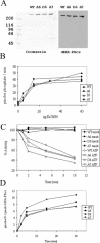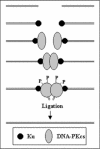Autophosphorylation-dependent remodeling of the DNA-dependent protein kinase catalytic subunit regulates ligation of DNA ends
- PMID: 15314205
- PMCID: PMC514382
- DOI: 10.1093/nar/gkh761
Autophosphorylation-dependent remodeling of the DNA-dependent protein kinase catalytic subunit regulates ligation of DNA ends
Abstract
Non-homologous end joining (NHEJ) is one of the primary pathways for the repair of ionizing radiation (IR)-induced DNA double-strand breaks (DSBs) in mammalian cells. Proteins required for NHEJ include the catalytic subunit of the DNA-dependent protein kinase (DNA-PKcs), Ku, XRCC4 and DNA ligase IV. Current models predict that DNA-PKcs, Ku, XRCC4 and DNA ligase IV assemble at DSBs and that the protein kinase activity of DNA-PKcs is essential for NHEJ-mediated repair of DSBs in vivo. We previously identified a cluster of autophosphorylation sites between amino acids 2609 and 2647 of DNA-PKcs. Cells expressing DNA-PKcs in which these autophosphorylation sites have been mutated to alanine are highly radiosensitive and defective in their ability to repair DSBs in the context of extrachromosomal assays. Here, we show that cells expressing DNA-PKcs with mutated autophosphorylation sites are also defective in the repair of IR-induced DSBs in the context of chromatin. Purified DNA-PKcs proteins containing serine/threonine to alanine or aspartate mutations at this cluster of autophosphorylation sites were indistinguishable from wild-type (wt) protein with respect to protein kinase activity. However, mutant DNA-PKcs proteins were defective relative to wt DNA-PKcs with respect to their ability to support T4 DNA ligase-mediated intermolecular ligation of DNA ends. We propose that autophosphorylation of DNA-PKcs at this cluster of sites is important for remodeling of DNA-PK complexes at DNA ends prior to DNA end joining.
Figures





References
-
- West S.C. (2003) Molecular views of recombination proteins and their control. Nature Rev. Mol. Cell Biol., 4, 435–445. - PubMed
-
- Lees-Miller S.P. and Meek,K. (2003) Repair of DNA double strand breaks by non-homologous end joining. Biochimie, 85, 1161–1173. - PubMed
-
- Valerie K. and Povirk,L.F. (2003) Regulation and mechanisms of mammalian double-strand break repair. Oncogene, 22, 5792–5812. - PubMed
-
- Lieber M.R., Ma,Y., Pannicke,U. and Schwarz,K. (2003) Mechanism and regulation of human non-homologous DNA end-joining. Nature Rev. Mol. Cell Biol., 4, 712–720. - PubMed
-
- O'Neill T., Dwyer,A.J., Ziv,Y., Chan,D.W., Lees-Miller,S.P., Abraham,R.H., Lai,J.H., Hill,D., Shiloh,Y., Cantley,L.C. and Rathbun,G.A. (2000) Utilization of oriented peptide libraries to identify substrate motifs selected by ATM. J. Biol. Chem., 275, 22719–22727. - PubMed
Publication types
MeSH terms
Substances
Grants and funding
LinkOut - more resources
Full Text Sources
Research Materials

